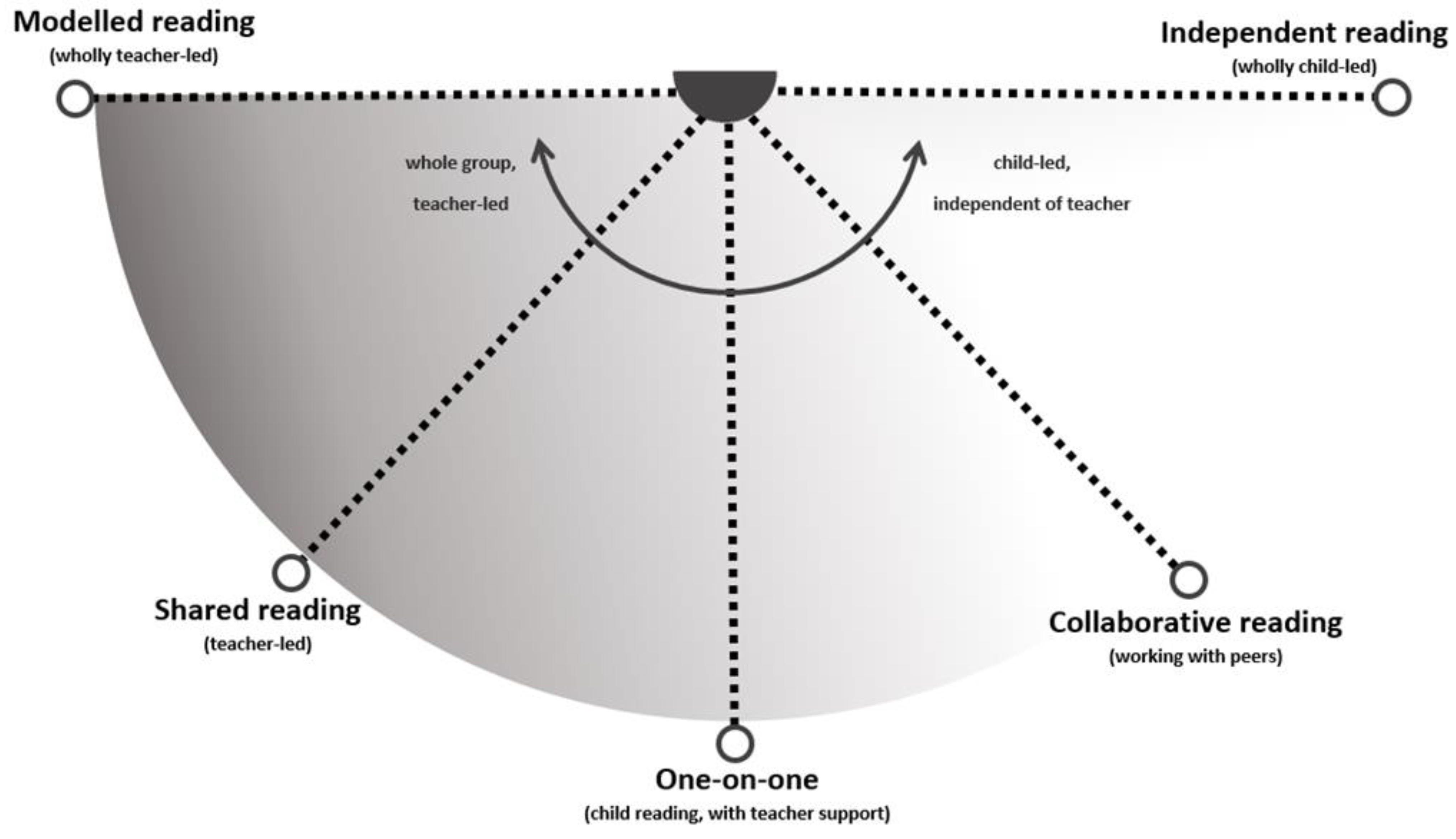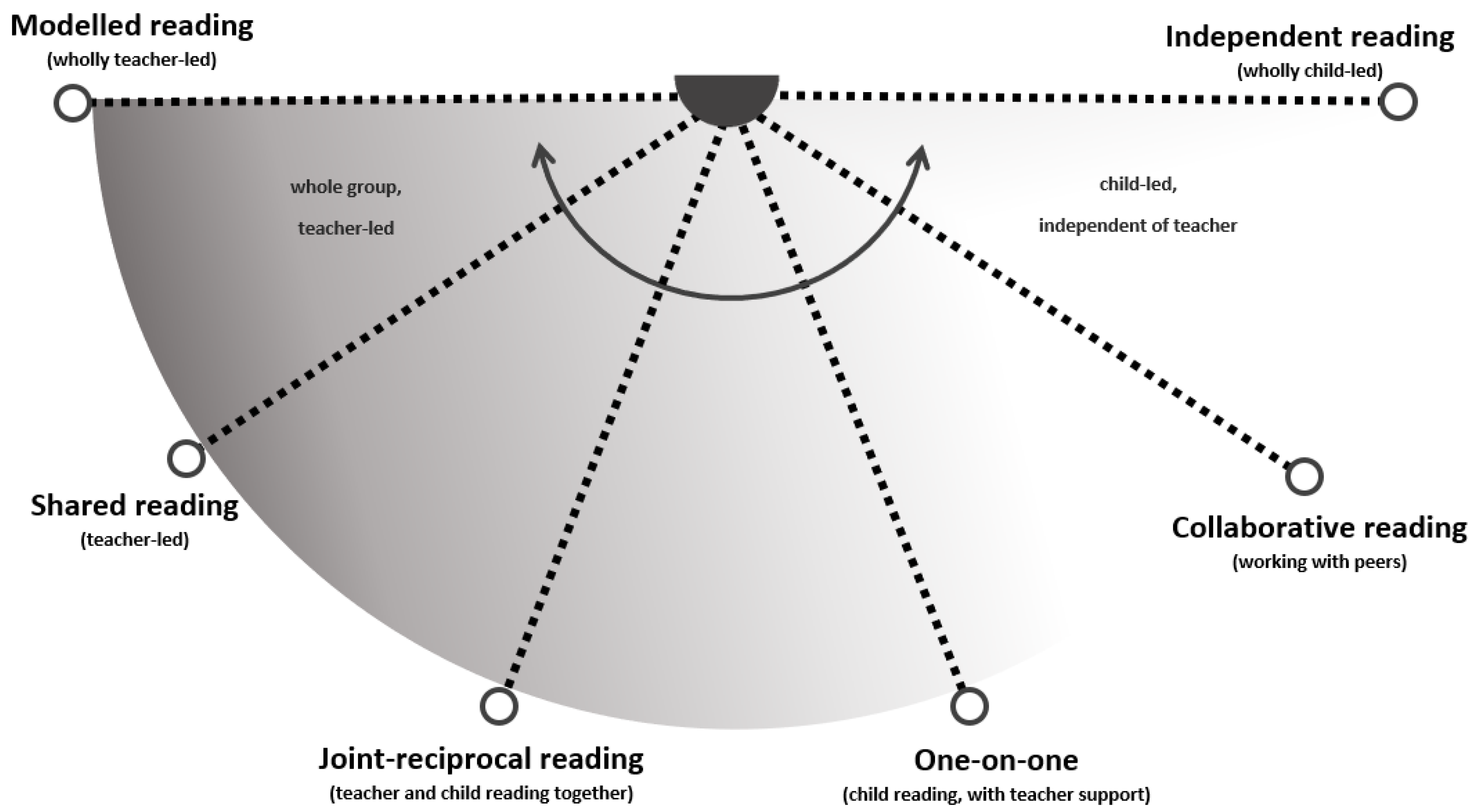The Barometer of Agency: Reconceptualising the ‘Guided Reading’ Teaching Approach
Abstract
:1. Introduction
Research Question
2. Literature Review
2.1. The Reading Teacher
2.2. The Reading Learner
2.3. Guided Reading
3. The Study
4. Method
Text Analysis
5. Results
GRR Teaching Approaches
During the book introduction… This may involve discussions [shared reading] and demonstrations about specific reading strategies [modelled reading].... [28] (p. 284)
6. Discussion
Each student is then given an opportunity to read in turn, a double-page spread at a time.
Sometimes guided reading is confused with round-robin reading and literature circles, but these three small-group instructional activities are different. In round-robin reading, students take turns reading aloud to the group, which is useful only as a model for fluency and expression.
7. Conclusions
8. Limitations
Funding
Institutional Review Board Statement
Informed Consent Statement
Data Availability Statement
Acknowledgments
Conflicts of Interest
References
- Pearson, P.D.; McVee, M.B.; Shanahan, L.E. In the Beginning: The Historical and Conceptual Genesis of the Gradual Release of Responsibility. In The Gradual Release of Responsibility in Literacy Research and Practice; McVee, M., Ortlieb, E., Reichenberg, J., Pearson, P.D., Eds.; Emerald Publishing Limited: Bingley, UK, 2019; pp. 1–21. [Google Scholar]
- Hill, P.W.; Crévola, C.A. Key Features of a whole-school, design approach to literacy teaching in schools. In Proceedings of the Australian Council for Educational Research (ACER) Conference 1999—Improving Literacy Learning: What does the Research Tell Us? Adelaide, Australia, 17–19 October 1999. [Google Scholar]
- The State of Queensland (Department of Education). Reading and Writing Centre. 2021. Available online: https://readingwritingcentre.education.qld.gov.au/resources/videos (accessed on 11 September 2021).
- Nicholas, M.; Veresov, N.; Cripps Clark, J. Guided reading—Working within a child’s zone of proximal development. Learn. Cult. Soc. Interact. 2021, 30 Part A, 100530. [Google Scholar] [CrossRef]
- The Australian Institute for Teaching and School Leadership (AITSL). Australian Professional Standards for Teachers. 2018. Available online: https://www.aitsl.edu.au/docs/default-source/national-policy-framework/australian-professional-standards-for-teachers.pdf (accessed on 10 September 2021).
- Ford, M.P.; Opitz, M.F. A national survey of guided reading practices: What we can learn from primary teachers. Lit. Res. Instr. 2008, 47, 309–331. [Google Scholar] [CrossRef]
- Stewart, S.; Te Riele, K.; Stratford, E. Literacy Teaching Practice in Tasmanian Schools. Stakeholder Report; University of Tasmania, Peter Underwood Centre: Hobart, Australia, 2019. [Google Scholar]
- Hattie, J. Understand the Teacher Standards. 2017. Available online: https://www.aitsl.edu.au/teach/standards/understand-the-teacher-standards (accessed on 10 September 2021).
- Pearson, P.D.; Gallagher, M.C. The instruction of reading comprehension. Contemp. Educ. Psychol. 1983, 8, 317–344. [Google Scholar] [CrossRef] [Green Version]
- Fisher, D.; Frey, N. Better Learning through Structured Teaching: A Framework for the Gradual Release of Responsibility, 2nd ed.; ASCD: Alexandria, VA, USA, 2014. [Google Scholar]
- Holmes, G.R. Resourcing improved learning. Pract. Adm. 2000, 22, 4–6. [Google Scholar]
- Department of Education, Victoria. Professional Development for Teachers: Keys to Life Early Literacy Program; Longman: Melbourne, Australia, 1997. [Google Scholar]
- Manyukhina, Y.; Wyse, D. Learner agency and the curriculum: A critical realist perspective. Curric. J. 2019, 30, 223–243. [Google Scholar] [CrossRef]
- Gaffney, J.S.; Jesson, R. We Must Know What They Know (and so must they) for Children to Sustain Learning and Independence. In The Gradual Release of Responsibility in Literacy Research and Practice; McVee, M., Ortlieb, E., Reichenberg, J., Pearson, P.D., Eds.; Emerald Publishing Limited: Bingley, UK, 2019; pp. 23–36. [Google Scholar]
- Powell, R.; McIntyre, E.; Rightmyer, E. Johnny won’t read, and Susie won’t either: Reading instruction and student resistance. J. Early Child. Lit. 2006, 6, 5–31. [Google Scholar] [CrossRef]
- Wilson, D.; Conyers, M. Developing Growth Mindsets: Principles and Practices for Maximizing Students’ Potential; ASCD: Alexandria, VA, USA, 2020. [Google Scholar]
- Ness, M.K. Think Aloud, Think Along, Think Alone: Gradually Releasing Students to Use Comprehension Strategies in Elementary Classrooms. In The Gradual Release of Responsibility in Literacy Research and Practice; McVee, M., Ortlieb, E., Reichenberg, J., Pearson, P.D., Eds.; Emerald Publishing Limited: Bingley, UK, 2019; pp. 217–227. [Google Scholar]
- Dole, J.A.; Duffy, G.G.; Pearson, P.D. Epilogue: Reflections on the Gradual Release of Responsibility Model: Where We’ve Been and Where We’re Going. In The Gradual Release of Responsibility in Literacy Research and Practice; McVee, M., Ortlieb, E., Reichenberg, J., Pearson, P.D., Eds.; Emerald Publishing Limited: Bingley, UK, 2019; pp. 245–263. [Google Scholar]
- Tompkins, G.; Campbell, R.; Green, D.; Smith, C. Literacy for the 21st Century: A Balanced Approach, 2nd ed.; Pearson: Melbourne, Australia, 2015. [Google Scholar]
- Vygotsky, L.S. The Collected Works of L.S. Vygotsky. Vol. 5: Child Psychology; Rieber, R., Ed.; Plenum: New York, NY, USA, 1998. [Google Scholar]
- Department of Education and Training (DET). Literacy Teaching Toolkit: The Four Resources Model for Reading and Viewing. State Government of Victoria, Australia. 2019. Available online: https://www.education.vic.gov.au/school/teachers/teachingresources/discipline/english/literacy/readingviewing/Pages/fourres.aspx (accessed on 11 September 2021).
- Hill, S. Developing Early Literacy: Assessment and Teaching, 2nd ed.; Eleanor Curtain Publishing: South Yarra, Australia, 2012. [Google Scholar]
- Shanahan, L.E.; Tochelli-Ward, A.L.; Rinker, T.W. The Ebb and Flow of Scaffolding: Thinking Flexibly about the Gradual Release of Responsibility during Explicit Strategy Instruction. In The Gradual Release of Responsibility in Literacy Research and Practice; McVee, M., Ortlieb, E., Reichenberg, J., Pearson, P.D., Eds.; Emerald Publishing Limited: Bingley, UK, 2019; pp. 53–66. [Google Scholar]
- Buckingham, J.; Meeks, L. Short-Changed: Preparation to Teach Reading in Initial Teacher Education; MultiLit Pty Ltd.: Macquarie Park, Australia, 2019; Available online: https://www.alea.edu.au/documents/item/2085 (accessed on 27 May 2020).
- O’Donnell, M. The UAM CorpusTool: Software for corpus annotation and exploration. In Proceedings of the XXVI Congreso de AESLA, Almeria, Spain, 3–5 April 2008. [Google Scholar]
- Braun, V.; Clarke, V. One size fits all? What counts as quality practice in (reflexive) thematic analysis? Qual. Res. Psychol. 2021, 18, 328–352. [Google Scholar] [CrossRef]
- Derewianka, B.; Jones, P. Teaching Language in Context, 2nd ed.; Oxford University Press: Melbourne, Australia, 2016. [Google Scholar]
- Fellowes, J.; Oakley, G. Language, Literacy and Early Childhood Education, 2nd ed.; Oxford University Press: Melbourne, Australia, 2014. [Google Scholar]
- Winch, G.; Ross Johnston, R.; March, P.; Ljungdahl, L.; Holiday, M. Literacy: Reading, Writing and Children’s Literature, 5th ed.; Oxford University Press: Melbourne, Australia, 2014. [Google Scholar]
- Seely Flint, A.; Kitson, L.; Lowe, K.; Shaw, S. Literacy in Australia: Pedagogies for engagement; Wiley: Milton, Australia, 2014. [Google Scholar]



| Experience | Description | Example from Text [19] |
|---|---|---|
| Teacher-led: child not active (modelled reading) | The teacher leads the experience. May include a demonstration or instructions. Children are passive or not mentioned at all. | “The teacher introduces the book” (p. 21) |
| Teacher-led: teacher and child reading (shared reading) | Teacher and child are both active. The teacher leads the experience. | “[teachers] then activate students’ background knowledge on a topic related to the book” (p. 403) |
| Teacher and child reading (joint-reciprocal reading) | Teacher and child are both active. Neither the child nor the teacher is assigned a lead role. | “The children and teacher read the text together” (p. 114) |
| Child-led: child reading with teacher support (scaffolded/advised by teacher) | Children lead the experience. The teacher is active when needed, to offer support. | “Students read the book or text. Teachers provide support to students with decoding and reading strategies as needed.” (p. 403) |
| Other children involved: child-led, peer-supported (collaborative reading) | Children are active, working with peers, independent of the teacher. | “With support from… classmates, students can comprehend the text” (p. 81) |
| Child self-directed: child-led, autonomous (independent reading) | Children are active, working independently of the teacher and of their peers. | “Students do the actual reading themselves, and they usually read silently at their own pace through the entire book.” (p. 402) |
| Other | Information unrelated to the actions of practice, e.g., organisation and planning. | “Guided reading lessons usually last 25 to 30 min.” (p. 39) |
| Text1 | Text2 | Text3 | Text4 | Text5 | Text6 | ALL TEXTS | ||||||||
|---|---|---|---|---|---|---|---|---|---|---|---|---|---|---|
| Feature | N | Percent | N | Percent | N | Percent | N | Percent | N | Percent | N | Percent | N | Percent |
| Total Units | 35 | 193 | 374 | 390 | 272 | 1021 | 2285 | |||||||
| THEME_TYPE | N = 20 | N = 116 | N = 218 | N = 204 | N = 145 | N = 539 | N = 1242 | |||||||
| - teacher involved * | 13 | 65.00% | 61 | 52.59% | 80 | 36.70% | 78 | 38.24% | 49 | 33.79% | 290 | 53.80% | 571 | 45.97% |
| - teacher not involved ** | 2 | 10.00% | 7 | 6.03% | 46 | 21.10% | 41 | 20.10% | 30 | 20.69% | 62 | 11.50% | 188 | 15.14% |
| - other | 5 | 25.00% | 48 | 41.38% | 92 | 42.20% | 85 | 41.67% | 66 | 45.52% | 187 | 34.69% | 483 | 38.89% |
| * TEACHER_INVOLVED | N = 13 | N = 61 | N = 80 | N = 78 | N = 49 | N = 290 | N = 571 | |||||||
| - teacher-led: child not active (modelled) | 0 | 0.00% | 21 | 34.43% | 31 | 38.75% | 17 | 21.79% | 6 | 12.24% | 39 | 13.45% | 114 | 19.96% |
| - child active # | 13 | 100.00% | 40 | 65.57% | 49 | 61.25% | 61 | 78.21% | 43 | 87.76% | 251 | 86.55% | 457 | 80.04% |
| # TEACHER_INVOLVED: CHILD_ACTIVE | N = 13 | N = 40 | N = 49 | N = 61 | N = 43 | N = 251 | N = 457 | |||||||
| -teacher-led: teacher and child reading (shared) | 2 | 15.38% | 22 | 55.00% | 5 | 10.20% | 38 | 62.30% | 10 | 23.26% | 91 | 36.25% | 168 | 36.76% |
| - teacher and child reading (joint-reciprocal) | 2 | 15.38% | 4 | 10.00% | 9 | 18.37% | 2 | 3.28% | 1 | 2.33% | 15 | 5.98% | 33 | 7.22% |
| - child-led: child reading with teacher support (scaffolded/advised) | 9 | 69.23% | 14 | 35.00% | 35 | 71.43% | 21 | 34.43% | 32 | 74.42% | 145 | 57.77% | 256 | 56.02% |
| ** TEACHER_NOT_ INVOLVED | N = 2 | N = 7 | N = 46 | N = 41 | N = 30 | N = 62 | N = 188 | |||||||
| - other children involved (collaborative) | 0 | 0.00% | 0 | 0.00% | 14 | 30.42% | 4 | 9.76% | 0 | 0.00% | 12 | 19.35% | 30 | 15.96% |
| - child self-directed (independent) | 2 | 100.00% | 7 | 100.00% | 32 | 69.57% | 37 | 90.24% | 30 | 100.00% | 50 | 80.65% | 158 | 84.04% |
Publisher’s Note: MDPI stays neutral with regard to jurisdictional claims in published maps and institutional affiliations. |
© 2022 by the author. Licensee MDPI, Basel, Switzerland. This article is an open access article distributed under the terms and conditions of the Creative Commons Attribution (CC BY) license (https://creativecommons.org/licenses/by/4.0/).
Share and Cite
Nicholas, M. The Barometer of Agency: Reconceptualising the ‘Guided Reading’ Teaching Approach. Educ. Sci. 2022, 12, 374. https://doi.org/10.3390/educsci12060374
Nicholas M. The Barometer of Agency: Reconceptualising the ‘Guided Reading’ Teaching Approach. Education Sciences. 2022; 12(6):374. https://doi.org/10.3390/educsci12060374
Chicago/Turabian StyleNicholas, Maria. 2022. "The Barometer of Agency: Reconceptualising the ‘Guided Reading’ Teaching Approach" Education Sciences 12, no. 6: 374. https://doi.org/10.3390/educsci12060374
APA StyleNicholas, M. (2022). The Barometer of Agency: Reconceptualising the ‘Guided Reading’ Teaching Approach. Education Sciences, 12(6), 374. https://doi.org/10.3390/educsci12060374






